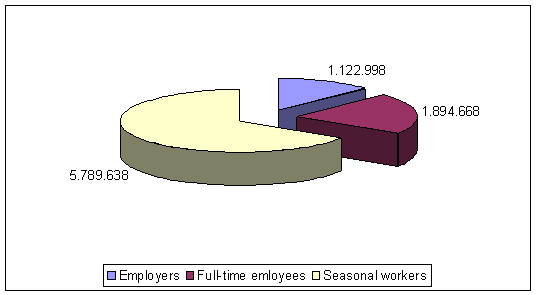Social Standards
Topics | Labour Market
Employment in agriculture is changing
With the acceptance of the accession countries into the European Union, the employment rate has dropped and the unemployment rate has risen. Agriculture is a special problem. Whereas the share of those working in agriculture stood at 4.1% in the EU-15, the proportion in the accession countries amounts to 13.2% (20.8% including Romania and Bulgaria). Following the enlargement (EU 25), the share is now 5.5% (EU 27: 7.6 %)[1].
The agricultural sector in the accession countries is undergoing a significant restructuring process, which is exerting structural pressure on the rural areas of these countries.
| BE | DE | EE | SF | IT | LT | NL | AT | SL | CZ | |
|---|---|---|---|---|---|---|---|---|---|---|
| Workforce | 1,303 | 24 | 99 | 1,402 | 238 | 295 | 200 | 59 | 168 | |
| Employees | 50 | 191 | 22 | 52 | 996 | 22 | 78 | 19 | 59 | 168 |
| Full-time | 15 | 131 | 22 | 6 | 107 | 20 | 28 | 9 | 1 | |
| Part-time/seasonal | 35 | 60 | 1 | 20 | 874 | 2 | 40 | 10 | 4 | |
| From the country | 18 | 2 | 4 | |||||||
| From the EU | 289 | 1 | 6 | 0 | ||||||
| From other countries | 1 | 60 | 1 | 0 | ||||||
| Unemployed | 25 | 20 | 5 | 4 | 39 |
Note on the data: The figures have been taken from various sources.
More or less everything is counted and registered in extensive statistics in the agriculture of the European Union; still, the picture of those working in this sector is incomplete. There are no reliable numbers. The following details from various sources are not complete; however, they do highlight major developments in the agricultural labour market of the EU.
The number of those permanently employed and subject to social insurance contribution amounts to more or less 1.9 million people in the extended EU. Nearly half of them work in the accession countries (0.8 million). There are over 1.1 million employers in the EU agriculture.
The service area in agriculture could not be registered in a differentiated manner within the framework of this study, as there is not reliable data material available yet. Still, new jobs for qualified agricultural workers have been created through so called “agricultural contractors” in countries, such as Germany and the Netherlands. Statisticians often add them to the tertiary (service) sector, however.
The number of seasonal workers in the EU agriculture is rising and estimated at approx. 4.5 million in 2006, comprising 420,000 from European third countries and 50,000 Non-Europeans. The accession countries are employing legal and illegal seasonal workers already today, for instance, in Russia, the Ukraine and Belarus. This trend is clearly emerging also in the “old” member states. The number of legal seasonal workers exceeds that of the full-time employed workers. In most accession countries, the situation is different. In those countries, there are (still) more full-time workers than seasonal workers. In some countries (e.g. Slovenia), this situation is changing already.
Employers and employees in the agricultural sector (year 2000)

| Employers | Full-time employees | Seasonal workers | |
|---|---|---|---|
| Belgium | 4,471 | 9,086 | 35,591 |
| Bulgaria | 374,000 | 1,000,000 | |
| Denmark | 38,000 | 28,000 | 2,500 |
| Germany | 50,000 | 198,000 | 297,500 |
| Estonia | 3,000 | 17,000 | 3,000 |
| Finland | 15,000 | 4,900 | 41,500 |
| France | 141,256 | 217,939 | 979,885 |
| Greece | 292,626 | 10,607 | 1,352,073 |
| Italy | 246,758 | 92,654 | 817,035 |
| Latvia | 9,600 | 5,000 | |
| Lithuania | 3,300 | 23,800 | |
| Malta | 1,035 | 2,000 | |
| Netherlands | 20,000 | 88,000 | 100,000 |
| Austria | 10,597 | 18,132 | 28,421 |
| Poland | 3,500 | 40,000 | |
| Portugal | 23,388 | 61,163 | 181,443 |
| Sweden | 28,000 | 28,000 | 20,000 |
| Slovakia | 3,940 | 84,290 | 10,000 |
| Slovenia | 127 | 197 | 1,382 |
| Spain | 100,000 | 130,000 | 679,000 |
| Czechia | ca. 5000 | 168,000 | 110,000 |
| Hungaria | 60,000 | 177,000 | 74,000 |
| United Kingdom | 78,000 | 112,300 | 51,308 |
| 1,122,998 | 1,894,668 | 5,789,638 |
- [1] Commission Communication, Second Progress Report on Economic and Social Cohesion, COM (2003) 34. final p.14
© 2006 PECO-Institut e.V. | LEGAL NOTICE | CONTACT